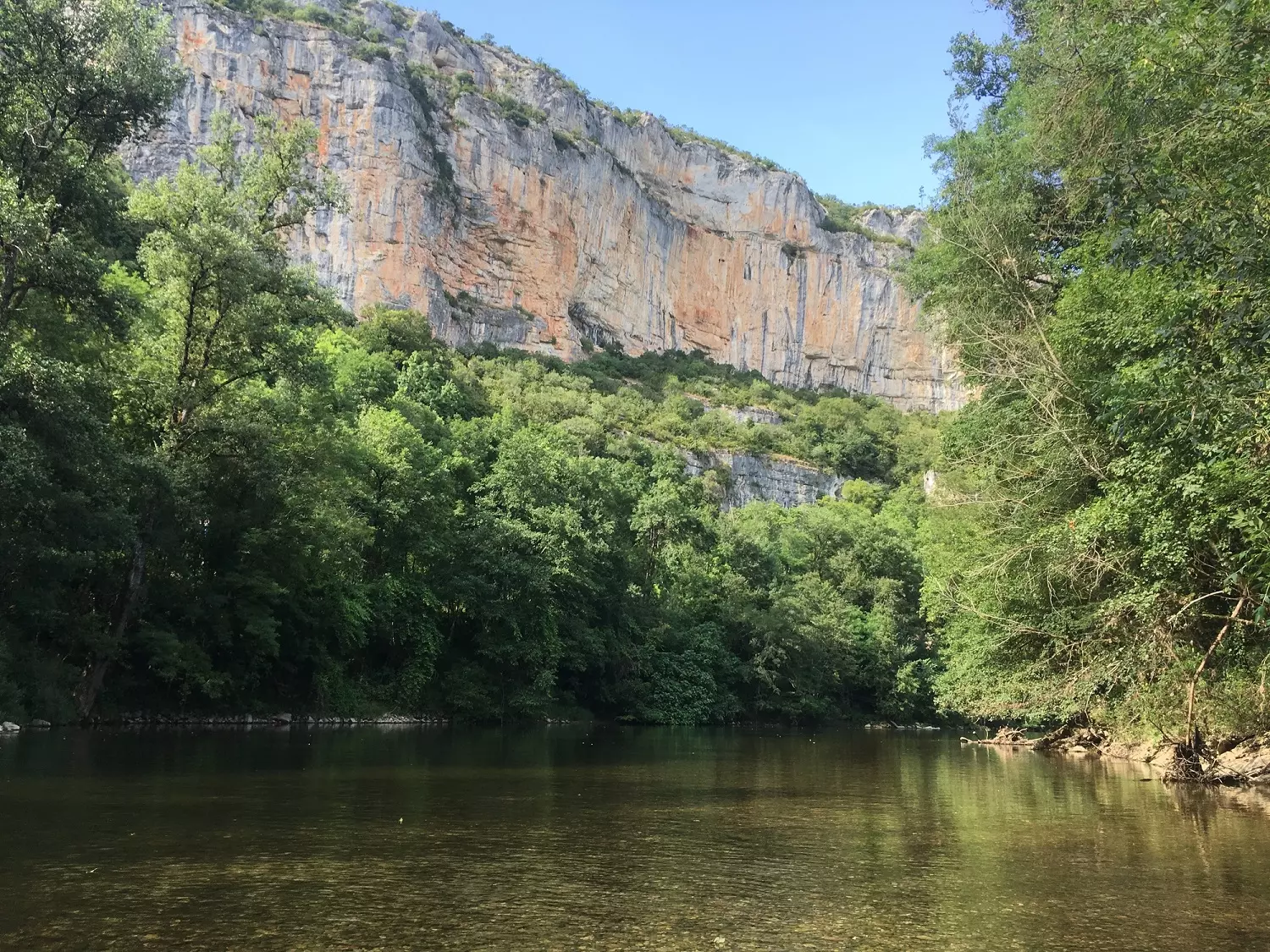[Originally published as Neandertals Continue to Surprise in the South of France. Photo of a river cliff in the general area of the Bruniquel Cave, France]
Research on a cave in southwestern France is once again highlighting how advanced Neandertals really were.
We already knew Neandertals were able to fashion sophisticated stone tools, use fire, and bury their dead. There’s also sparse evidence of bone tools, jewelry, and pigments all made by Neandertals. In the young-age creationist community, the consensus has long been that Neandertals are human descendants of Adam and Eve. Thus, we are not surprised to find these evidences of mental sophistication and culture. We would expect that even the most disadvantaged people would still exhibit their basic humanity.
In an online paper for the journal Nature, Jaubert and colleagues describe the radiometric dating of strange stone structures in the Bruniquel Cave, abuot 330 miles south of Paris. The cave contains two stone rings and several other piles of stone, all made from broken cave formations (stalagmites), and the stalagmites bear abundant stains from burning in a fire.
It appears that in the past, some person or persons spent a great deal of time in that cave breaking stalagmites, arranging them, and starting fires on the stones. For what purpose we do not know. Until recently, we weren’t even sure how long ago these stone structures were made.
The collapsed entrance to the cave was re-opened for the first time in 1990, and carbon dating was done on a single burned bone from the larger of the two rings. That dating indicated that the bone had been burnt about 47,600 years ago, but that is about the limit of carbon dating. Even with that carbon date, the rings could have been much older.
Joubert and colleagues conducted more thorough dating on samples of several of the stalagmites from the structure. They found that the fragments exhibited two growth patterns. The first occurred while the stalagmites were still upright, but the outer layers of rock were deposited after the stalagmites were broken and placed in the rings or piles. The date of that transition from upright to prone consistently registered as 176,500 years old (+/- 2,100 years). That date makes the rings the earliest known artificial structure by about 150,000 radiometric years. At that radiometric age, there are no known Homo sapiens in residence in southern France. The only people living in the area at that “date” were Neandertals. These were stone rings that were likely made by Neandertals.
Questions
This work raises a number of fascinating and exciting questions for young-age creationists. First, we have to admit that we don’t have a “smoking gun” that identifies the maker of these structures. They are clearly made by people, and we conclude only indirectly that the people were Neandertals because they were the only ones around. But there isn’t any direct evidence from the cave itself that Neandertals made these structures, although that may be forthcoming. Any conclusions we draw about Neandertals from this discovery must therefore be taken with a grain of salt.
If the stone rings really were made by Neandertals, we can surmise once again that Neandertals are surprisingly advanced, far more than their “brutish” reputation would reveal. What exactly those stone circles were for and why people burned things on them we may never know for sure. We can certainly rule out things like shelter: these structures are too short and inside a cave, which is a natural shelter already. These rings imply some kind of ritual use.
Their Neanderthal makers were sophisticated thinkers indeed.
Young-age creationists need to wrestle with the dating of this site. It’s a fascinating question:
- First, we have a well-developed cave complete with stalagmites that were there when the people arrived.
- Then, after the stalagmites were broken, additional stone was deposited on them in their prone position in the ring. Thus, we have stalagmite growth before and after the people were there.
- Finally, we have the results of the uranium dating from 22 stalagmite samples. Even though we don’t recognize the accuracy of the absolute date, we still can marvel at how consistent the relative dates are. The youngest date obtained was 175,200 years ago (+/- 800 years), and the oldest date was 177,900 years ago (+/- 1,500 years). These are amazingly consistent dates.
Thus, any effort of creationists to incorporate these results into a young-age creationist time frame will need to consider both the formation of the stalagmites and the consistency of the uranium dating. We already have reason to believe that cave formation would be accelerated during the post-Flood due to residual catastrophism lasting well after the Flood “ended,” but there has been little work done on radiometric dating of cave deposits.
Even without knowing exactly when these structures were built, we can still be amazed at how much this study extends the evidence of human constructions. Previously, the earliest human structures were only tens of thousands of years old. Conventional dating places the earliest cities at no more than ten thousand years old.
Nevertheless, since the dispersal of humans after Babel included such human forms as Homo erectus and Neandertals, then the truly earliest settlement must have been immensely earlier on the conventional calendar, even though the evidence of such ancient structures are unknown. These stone rings don’t fill in that history completely, but they do show that people were making structures much “earlier” than we used to think.
Regardless of the timing of these formations, they remain an amazing testament to the sophistication and intelligence of their makers.
Jaubert et al. 2016. Early Neanderthal constructions deep in Bruniquel Cave in southwestern France. Nature doi:10.1038/nature18291.







